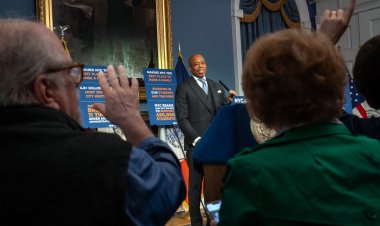U.S. economic growth defies forecasts, in boost for ‘Bidenomics’
The rate of growth exceeded the 2 percent expansion notched in the first quarter of the year.


U.S. economic growth accelerated in the second quarter of the year, surpassing analysts’ forecasts and bolstering the Biden administration’s argument that the expansion is gaining strength.
The government said Thursday that GDP grew 2.4 percent at an annualized pace from April through June, the latest good news for the White House this week after both Federal Reserve economists and the Congressional Budget Office predicted the U.S. would avert a recession this year.
As President Joe Biden heads into the election season, his stewardship of the economy looms as one of the biggest issues, with polls showing voters giving him low marks even as the White House credits his policies for the surprising resilience of the job market and rising consumer confidence.
“This is another one of those inside-Washington ‘Bidenomics’ wins — you get a very resilient household sector and a private domestic economy that looks actually quite solid,” said Joe Brusuelas, chief economist at the accounting firm RSM.
“If one was looking for the definition of resilience, it would be the American economy,” he said, adding that it “continues to defy expectations.”
The rate of growth exceeded the 2 percent expansion notched in the first quarter of the year. Economists surveyed by Bloomberg and the Wall Street Journal expected GDP — the broadest measure of domestic production — to grow by 1.5 percent in the second quarter.
The first estimate of second-quarter growth from the Commerce Department comes a day after Federal Reserve Chairman Jerome Powell told reporters that Fed staff are no longer forecasting a recession this year. Still, the Fed hiked interest rates again on Wednesday, the 11th time since March 2022, to the highest level in more than two decades in a bid to tame inflation.
Increases in consumer spending, nonresidential fixed investment, private inventory investment and government spending at the state, local and federal levels drove the increase in GDP, according to the Bureau of Economic Analysis. Exports and residential fixed investment decreased.
While a tight labor market has spurred wage growth and low unemployment, inflation — which hit its highest level in four decades last year before slowly starting to come down in response to aggressive Fed rate hikes – and high borrowing costs have dampened many voters’ view of the economy.
Just over 38 percent of Americans approve of Biden’s economic management while nearly 58 percent disapprove, according to a RealClear Politics average of polls conducted over the last month.
Overall inflation rose 3 percent on an annual basis in June — the lowest level since March 2021 — the government reported this month. Powell on Wednesday demurred on the pace of future rate hikes.
“For a number of reasons, I think we’re going to see a meaningful improvement in the inflation path in the back half of this year, and I think that’s the decisive issue for the Fed,” said David Mericle, chief U.S. economist at Goldman Sachs Research.












